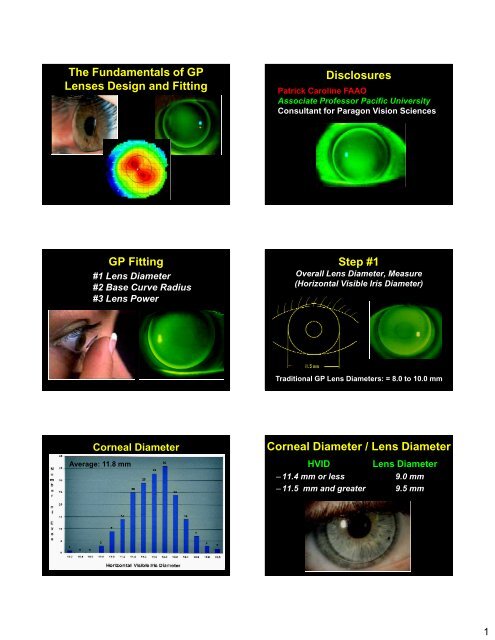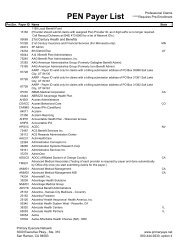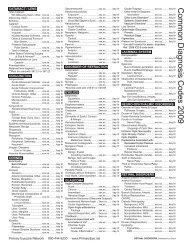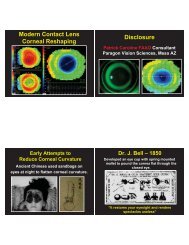The Fundamentals of GP Lenses Design and Fitting Disclosures GP ...
The Fundamentals of GP Lenses Design and Fitting Disclosures GP ...
The Fundamentals of GP Lenses Design and Fitting Disclosures GP ...
Create successful ePaper yourself
Turn your PDF publications into a flip-book with our unique Google optimized e-Paper software.
<strong>The</strong> <strong>Fundamentals</strong> <strong>of</strong> <strong>GP</strong><br />
<strong>Lenses</strong> <strong>Design</strong> <strong>and</strong> <strong>Fitting</strong><br />
<strong>Disclosures</strong><br />
Patrick Caroline FAAO<br />
Associate Pr<strong>of</strong>essor Pacific University<br />
Consultant for Paragon Vision Sciences<br />
Central<br />
Clearance<br />
<strong>GP</strong> <strong>Fitting</strong><br />
#1 Lens Diameter<br />
#2 Base Curve Radius<br />
#3 Lens Power<br />
Step #1<br />
Overall Lens Diameter, Measure<br />
(Horizontal Visible Iris Diameter)<br />
Traditional <strong>GP</strong> Lens Diameters: = 8.0 to 10.0 mm<br />
Corneal Diameter<br />
Average: 11.8 mm<br />
Corneal Diameter / Lens Diameter<br />
HVID<br />
– 11.4 mm or less<br />
– 11.5 mm <strong>and</strong> greater<br />
Lens Diameter<br />
9.0 mm<br />
9.5 mm<br />
1
Step #2 Base Curve Radius<br />
Relationship to “Flat K”<br />
ON FLAT “K”<br />
BC = 42.00 D.<br />
Alignment <strong>Fitting</strong><br />
Relationship<br />
<strong>GP</strong> <strong>Fitting</strong> Factors<br />
• <strong>The</strong> center <strong>of</strong> the lens<br />
should clear the<br />
central cornea.<br />
• <strong>The</strong>re should be a<br />
midperipheral contact<br />
point along the horizontal<br />
meridian<br />
(8.25) (8.05)<br />
• <strong>The</strong> lens should maintain<br />
unobstructed movement<br />
along the vertical<br />
meridian<br />
Base Curve<br />
41.00 D. 8.25 mm<br />
0 microns<br />
Base Curve<br />
42.00 D. 8.05 mm,<br />
20 microns<br />
2
Clear the Corneal Apex<br />
41.00 D 8.25 mm<br />
42.00 D. 8.05 mm<br />
<strong>GP</strong> <strong>Fitting</strong> Factors<br />
• <strong>The</strong> center <strong>of</strong> the lens<br />
should clear the central<br />
cornea.<br />
• <strong>The</strong>re should be a midperipheral<br />
contact point<br />
along the horizontal<br />
meridian<br />
42.00 D<br />
8.05 mm<br />
• <strong>The</strong> lens should maintain<br />
unobstructed movement<br />
along the vertical<br />
meridian<br />
Mid-Peripheral Eccentricity<br />
42.00 D<br />
0.60<br />
0.40<br />
0.20<br />
0.60<br />
0.50<br />
0.40<br />
Simulated Fluorescein Pattern<br />
Vertical<br />
40 microns<br />
Normal Tear Film Thickness<br />
10 to 20 microns<br />
Optimum Horizontal<br />
10 - 20 microns<br />
3
Sodium Fluorescein Patterns<br />
Darker<br />
Green<br />
thinner<br />
tear film<br />
thickness<br />
Brighter<br />
Green<br />
thicker<br />
tear film<br />
thickness<br />
Flat “K”<br />
41.75<br />
CA 1.75 D.<br />
On Flat “K”<br />
On Flat “K”<br />
Flat<br />
Flat ‘K’:<br />
41.75 D.<br />
Base Curve:<br />
41.75 D.<br />
Flat<br />
Flat ‘K’:<br />
41.75 D.<br />
Base Curve:<br />
41.75 D.<br />
G<br />
0.50 D. Steeper than “K”<br />
0.50 D. Steeper than “K”<br />
Alignment<br />
Flat ‘K’:<br />
41.75 D.<br />
Base Curve:<br />
42.25 D.<br />
Alignment<br />
Flat ‘K’:<br />
41.75 D.<br />
Base Curve:<br />
42.25 D.<br />
4
0.50 Steeper than “K”<br />
0.50 D. Steeper than “K”<br />
Steep<br />
Flat ‘K’:<br />
41.75 D.<br />
Base Curve:<br />
42.75 D<br />
Steep<br />
Flat ‘K’:<br />
41.75 D.<br />
Base Curve:<br />
42.75 D<br />
Alignment<br />
<strong>Fitting</strong><br />
Relationship<br />
Apical<br />
Clearance<br />
<strong>Fitting</strong><br />
Relationship<br />
Apical<br />
Touch<br />
<strong>Fitting</strong><br />
Relationship<br />
10 to 25 microns<br />
26 microns or Greater<br />
9 microns or Less<br />
<strong>GP</strong> <strong>Fitting</strong> Factors<br />
• <strong>The</strong> center <strong>of</strong> the lens<br />
should clear the central<br />
cornea.<br />
• <strong>The</strong>re should be a<br />
midperipheral contact<br />
point along the horizontal<br />
meridian<br />
• <strong>The</strong> lens should maintain<br />
unobstructed movement<br />
along the vertical<br />
meridian<br />
Inferior Clearance<br />
Inferior Clearance<br />
5
Axial Map<br />
Elevation Map<br />
N<br />
Management <strong>of</strong> Astigmatism<br />
With Gas Permeable <strong>Lenses</strong><br />
Incomplete Astigmatism<br />
Limbus-to-Limbus<br />
Spherical <strong>Design</strong><br />
Toric <strong>Design</strong><br />
Incomplete/Central<br />
Limbus-to-Limbus<br />
Angle Lamda<br />
6
With-the-Rule Astigmatism<br />
Against-the-Rule Astigmatism<br />
7
K’s 43.00 @ 175<br />
46.00 @ 085<br />
Base Curve<br />
43.25 D<br />
7.80 mm<br />
43.25 D. 7.80 mm<br />
44.75 D. 7.55 mm<br />
8
Spherical <strong>Design</strong><br />
Step #3<br />
Lens Power<br />
1. Spherical<br />
overrefraction<br />
Toric <strong>Design</strong><br />
If the VA is not<br />
correctable to 20/20<br />
or BCVA<br />
2. Sphero-cylinder<br />
overrefraction<br />
Alignment<br />
Lens Power<br />
Steeper Than “K<br />
Flatter Than “K”<br />
Peripheral Lens <strong>Design</strong><br />
R<strong>GP</strong> Lens Periphery<br />
• Multipule Spherical Radii<br />
• Aspheric<br />
• Tangent<br />
9
Secondary Curve<br />
<strong>The</strong> Secondary Curve provides clearance <strong>of</strong> the<br />
lens in primary gaze <strong>and</strong> alignment with lateral<br />
gaze.<br />
Example:<br />
Base Curve<br />
42.75 D (7.90 mm)<br />
Secondary Curve Radius<br />
8.90 mm<br />
Secondary Curve Width<br />
0.4 mm<br />
Peripheral Curve<br />
It is designed to clear the peripheral cornea <strong>and</strong><br />
Limbus, radius 10.00 to 12.50<br />
Example: Base Curve<br />
42.75 D (7.90 mm)<br />
Secondary Curve Radius<br />
8.90 mm, Width 0.4 mm<br />
Peripheral Curve Radius<br />
11.50 mm<br />
Peripheral Curve Width =<br />
0.3 mm<br />
Adequate Clearance<br />
Inadequate Clearance<br />
Pr<strong>of</strong>ile Analyzer<br />
<strong>Design</strong> A<br />
11.0 mm<br />
47.50 D. 7.10 mm<br />
A Good Blend<br />
A Poor Blend<br />
<strong>Design</strong> B<br />
11.0 mm<br />
47.50 D. 7.10 mm<br />
10
Fluorescent Tube Technique<br />
No SC or PC’s<br />
SC <strong>and</strong> PC’s<br />
Blended SC <strong>and</strong> PC’s<br />
Burton Lamp<br />
Fluorescent Tube Technique A Good Blend A Poor Blend<br />
Edge <strong>Design</strong><br />
Edge Contour<br />
<strong>The</strong> Lens Edge is<br />
divided into three<br />
zones.<br />
Anterior Zone<br />
Posterior Zone<br />
Edge Apex<br />
11
Edge <strong>Design</strong><br />
<strong>GP</strong> Lens <strong>Design</strong><br />
Unfinished Lens <strong>Design</strong><br />
Finished Lens Edge<br />
43.25 D.<br />
12












